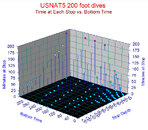A ScubaBoard Staff Message...
This is one of two threads that has been opened since the other thread was closed. I posted the following warning on the other one:
The reason the other thread was closed was because of the flurry of personal attacks. In some cases, posts that responded to other posts that had been deleted due to personal attacks had to be deleted as well because of the reference to a deleted posts. It was a very difficult process to separate the wheat from the chaff, and I sincerely hope that we can discuss this important topic while staying on the topic and not the individuals involved.
The concern is the fallacy of the
ad hominem attack, in which the character of a person is attacked rather than the argument at issue. That sounds simple enough, but it is actually tricky, because not all personal attacks are fallacies. There are cases in which it is legitimate to question the credentials of an individual making a case, and it is possible to question the motives of a person making a case. For example, when Andrew Wakefield was shown to have a major financial interest in getting people to believe that autism was linked to vaccinations, it severely undermined his credibility by showing a motivation for misreporting data, which he also was shown to have done. With both of those problems clearly demonstrated,
ad hominem comments became legitimate matters of discussion. (See the link in this paragraph for further discussion of this.)
In the previous thread, words like
fake and
phony were red flags because of the implication of an attack on an individual's character. If two people look at data and draw different conclusions, that is a disagreement, and one can question the legitimacy of an opposing interpretation. To say that a position is
fake or
phony, on the other hand, means that the other's position is a deliberate misrepresentation with the intent to deceive, and it is thus a personal attack. As stated in the last paragraph, if you have clear information showing that the opposing view is in fact a deliberate attempt to deceive, then that is a legitimate point, but you had better be able to prove that intent to the satisfaction of others, especially the moderators. If someone has accused you of such intent, you of course will have the right to respond.
Please be careful in this thread--don't make it personal!







